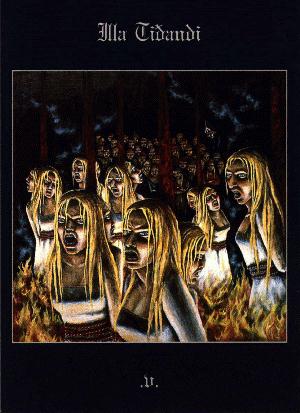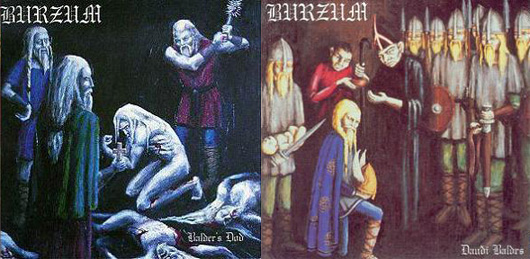Hell in Hellas
Cuenta la mitología que hace mucho tiempo existía en Grecia un reino habitado únicamente por mujeres. Eran las amazonas, mujeres guerreras de Temisciara. Su despiadada crueldad y salvajismo aún estremecen: Se extirpaban el pecho para poder disparar mejor con el arco y las flechas, y atacaban las regiones vecinas para secuestrar a los hombres, violarlos y asi asegurar la descendencia de la tribu, compuesta únicamente por mujeres. Después de la noche, mataban a los hombres, y al cabo de 9 meses, si parían un niño, también lo mataban, y si, por el contrario, era una niña, entonces la alimentaban y la adiestraban en el arte de la guerra. Su ferocidad las hizo famosas en todo el mundo de la Edad Heroica.
Miles de años después, de esas mismas tierras legendarias surgen tres nuevas amazonas: Astarte, la primera banda black metal compuesta totalmente por chicas. Pero no te esperes algo pastelero o melódico, ya que las Astarte tocan furioso y ultrajante black metal al estilo Darkthrone o Gorgoroth. La violencia y agresividad de su música no desmerece en nada la aterradora fama de aquellas míticas guerreras helénicas que una vez atemorizaron el mundo y de las que son herederas…
A continuación sigue una interesante entrevista con las tres amazonas, Kinthia, Nemesis y Tristessa.
Astarte es aún una banda relativamente desconocida. Por qué no nos presentas la banda? Cómo, cuándo y quién formó Astarte?
La decisión de formar Astarte fue tomada por las tres. Nos formamos en septiembre de 1995 con el nombre de Lloth y en mayo de 1997 grabamos nuestra primera demo “Dancing In The Dark Lakes Of Evil”. Después cambiamos el nombre de la banda a Astarte, que es mucho más representativo de nuestra música. Entonces la recién creada discográfica griega Black Lotus Records nos ofreció un contrato y a finales de 1997 grabamos nuestro primer álbum “Doomed Dark Years”, que contiene 8 canciones de las cuales una es un bonus (remix) de una de las que aparecía en la demo.
Vuestras influencias son más del black metal noruego que del griego, por qué? Qué os hizo escoger este “camino”? Cuáles dirías que son las principales diferencias entre el black metal griego y el noruego? Crees que es acertado separar las bandas por países?
Después de todo, todo es black metal, no crees? Es verdad, pero nuestro interés por la escena noruega no significa que no nos guste la escena griega o mundial. No separamos a las bandas por países. Es sencillamente que tenemos influencias noruegas. Somos un grupo que aún no ha concluído de definir un estilo musical personal, como le pasa a muchas nuevas bandas. Noruega tiene una importante escena metal que encaja mejor con nuestras preferencias.
Qué os inspira o influencia? Cuáles son las principales fuentes de inspiración? Qué tipo de emociones y sentimientos creeis que son necesarios incluir en la música?
Estamos principalmente influenciados por Gorgoroth, Darkthrone y Satyricon. Nuestra inspiración viene de la Naturaleza (la tierra y la luna y el espacio). También expresamos muchos elementos de nuestro interior. Por una parte alcanzamos nuestros deseos y pensamientos más oscuros y por otra sentimientos más atmósfericos y claros. Nos gusta combinar sentimientos extremos como la tristeza y la felicidad, la rabia y la calma. La música sin sentimiento (incluído el black metal) es una disharmonía y pierde su validez y vividez.
Quién hace qué en Astarte? Cómo es el proceso de composición? Cómo se divide el trabajo entre los miembros? Qué aspectos asume cada una de vosotras? Qué cualidades tenéis, que os hace ser la combinación perfecta para la marcha de Astarte?
Astarte se compone de Kinthia (voces, guitarras, guitarras acústicas, sintetizadores), Nemesis (guitarras, guitarras acústicas, sintetizadores), Tristessa (bajo, guitarras acúsicas, sintetizadores) y Aivar como batería de sesión. En el CD cada una de nosotras compuso dos canciones, así que el material es representativamente justo. Intercambiamos nuestras opiniones sobre cada detalle. Cada una de nosotras presenta sus ideas y elementos musicales personales, pero lo más importante para que un grupo sobreviva es una buena comunicación entre todos los miembros del grupo. Aparte de nuestra perfecta comunicación somos también muy buenas amigas y eso es nuestra fuerza conductiva.
Quién escribe las letras y de qué hablan? Qué temas tratáis y cuál es el mensaje que queréis transmitir a través de vuestras letras?
Mis letras versan sobre sitios y personajes mitológicos. Todo brota de mi imaginación y siempre intento transmitir nuestras creencias paganas. Las letras se presentan de una manera poética e intento darle vividez a mis historias. En nuestro Cd también hay una oscura história conceptual dedicada a Astarte. Del resto de mis letras escogería “Doomed Dark Years” como la más representativa.
En mi opinión el 90% de los álbumes black metal actualmente son de una calidad tan baja que honestamente creo que jamás deberían haber sido editados en CD. Cuál es tu opinión?
Es verdad que hay muchas bandas ahí fuera que no brindan nada nuevo a la escena black metal. Creemos que esto también va por algunas bandas viejas a las que se les han agotado las ideas pero también por algunas bandas nuevas que intentan copiar a las viejas. Hay muchas bandas que hacen que nuestra escena crezca y se expanda, como Jackal’s Truth, Sickness, Bakxeia Neraida (bueno, Bakxeia Neraida no son black metal; es música antigua griega de flauta -NDT), Godblood, Vechira, Obsculum Infame, Svartsyn, Handful Of Hate… Como ya he dicho las tres componemos. Nuestras ideas e inspiraciones son diferentes, así que las tres tocamos diferente.
Por lo que sé, tú, Tristessa, tocabas también en Vorphalack, aún tocas con ellos? Qué tocabas en ese grupo, y cómo ha afectado a Astarte el ser miembro de Vorphalack? Los otros miembros del grupo, tienen algún otro proyecto o grupo?
Fuí una componente importante de Vorphalack hasta que tres nuevos miembros se unieron a la banda. Algunos del grupo decían que las mujeres eramos seres inferiores y que no podíamos tocar en una banda black metal, así que me echaron de “su” banda. He dado mucho a Vorphalack. Yo y los miembros originales sacamos un split-LP con Zephyrous. Estoy muy orgullosa de ello y estoy convencida de que ese material era y es el más puro de Vorphalack. Pero bueno, les deseo un futuro mejor porque Vorphalack es aún una parte de mi experiencia musical y de mi misma. Ahora no tenemos ningún otro proyecto o banda, pero nunca decimos que no si una banda nos pide ayuda.
Qué opinas de la escena griega y cuáles son tus bandas favoritas? Cómo os respalda la escena griega?
Los últimos 5 años la escena griega metal ha crecido muy rápido. Ha habido una evolución en todos los géneros de metal. Muchos grupos han sacado sus álbumes a escala mundial y también les vemos tocar en directo. Algunas de mis bandas favoritas son Kawir (también conocidos como Kaveiros -NDT), Necromantia, Zephyrous, Legion Of Doom, Invocation, Obscure Noctis, Left Hand Path, Thou Art Lord, Order Of The Ebon Hand… Esperábamos más support de la escena metal griega, pero ya está bien porque recibimos respaldo de grupos y gente del extranjero y estamos totalmente satisfechas con ello.
Cómo ha sido la respuesta internacional a vuestro álbum?
Es cierto que parece que la gente de ahí fuera aprecia nuestra música. Recibimos cartas de sitios en los que jamás hubieramos pensado que hubiera metal como Serbia, Malasia, Eslovenia… Su support significa mucho para nosotras. Es muy interesante intercomunicarse con gentes de países de todo el mundo. Aprendemos cosas sobre ellos, sobre su cultura, sobre su historia… En tanto nos respaldan, les respaldamos.
No dudo para nada de que merecierais vuestro contrato, únicamente logrado con vuestro talento musical y en nada más, pero ya que vuestra discográfica (la griega Black Lotus Records) puso una etiqueta en el CD promocional que recibí diciendo “Primer grupo black metal íntegramente compuesto por chicas”, me preguntaba qué opináis sobre eso… Qué opinais honestamente de ser presetadas como “la primera banda black metal del mundo totalmente compuesta por chicas”?
Priemero, como tú dices, no somos responsables de la promoción de la banda, sino de hacer música. Nuestra discográfica se encarga de la promoción. Por supuesto que el hecho de haber sido la primera banda del mundo con todos los miembros femeninos nos va bien, pero jamás contamos con ello. Tenemos nuestras habilidades artísticas para sacar nuestra banda adelante. Si fuéramos un gupo horrible y no tuvieramos nada que ofrecer a la escena black metal, entonces sólo nos promoveriamos en esa dirección, pero no es el caso.
Por supuesto que no. De hecho, le he puesto cuatro eMes a vuestro álbum, así que… [Nota: 5 eMes es la máxima puntuación]Otro rasgo distintivo de la banda es la voz, que nunca pensarías que se trata de una chica. Es brutal! Sobre eso le pregunto… Kinthia, fué dificil aplicarse a tus agresivas vocalidades? Cuales son tus objetivos respecto a tu manera de cantar, continuarás en el mismo estilo que en vuestro debut? Cómo te las arreglas para cantar de esa manera?
No fué muy dificil. Mis caóticos gritos salen sin absolutamente ninguna distorsión. Continuaré cantando así aunque añadiré ideas nuevas más agresivas. También me gustaría hacer ciertas mejoras para obtener resultados aún más caóticos. Me las arreglo para cantar así porque somos una TRUE black metal band.
Cuáles son vuestros planes futuros? Conciertos, tours? Cómo ves a Astarte dentro de 5 años?
Ya hemos empezado a componer material nuevo, así que por el momneto estamos trabajando en él y cuando acabemos esperamos entrar a estudio para nuestro próximo álbum. No tenemos planes de hacer conciertos porque no tenemos batería fijo. En 5 años esperamos estar en el sitio que merecemos.
Bueno, eso es todo; añade lo que quieras para cerrar esta entrevista…
Antes que nada queremos agradecerte por esta larga e interesante entrevista. Esperamos el mejor futuro para la escena griega. Siempre suportaremos el underground. A big fuck off to all those who didn’t believe in us!
Entrevista hecha por Karsten Hamre de The Zodiac Chronicles (Islandia).
Traducida del inglés por Metallykon para Webzine Metalzin
![]()









